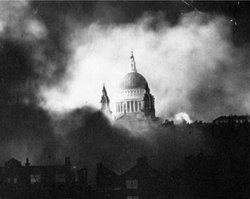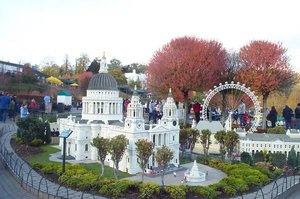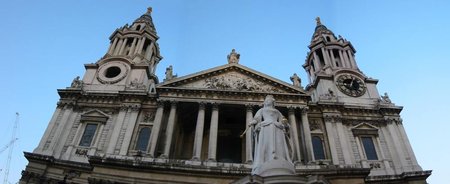St Paul's Cathedral
|
|
- This article is about the cathedral in London. For other uses of the term, see Cathedral of Saint Paul.
Missing image StPaulsCathedralSouth.jpg St Paul's Cathedral from the south |
Missing image Saint.pauls.from.ludgate.hill.arp.750pix.jpg St Paul's Cathedral from Ludgate Hill during cleaning in 2004 |
Missing image StPauls-Night.jpg St Paul's Cathedral at night |
St Paul's Cathedral is a cathedral on Ludgate Hill, in the City of London in London, and the seat of the Bishop of London. The present building dates from the 17th century, and is generally reckoned to be London's fourth St Paul's Cathedral, although the number is even higher if every major medieval reconstruction is counted as a new cathedral.
| Contents |
The previous cathedrals
The see of London dates from 604 AD, and its cathedral has always been situated on Ludgate Hill and dedicated to St Paul. Ludgate Hill itself has long been associated with religion. It is believed that it was originally the site of an ancient megalith and then later a temple dedicated to the goddess Diana, in alignment with the Apollo Temple which once stood at Westminster.
The first cathedral was built by the Saxons in wood. It burned down in 675 AD and was rebuilt, again in wood, ten years later. After this version was sacked by the Vikings in 962, the "second" St Paul's was built, this time mainly in stone.
The third St Paul's (known as Old St Paul's), was begun by the Normans after the late Saxon cathedral suffered in a fire of 1087. Work took over two hundred years, and a great deal was lost in a fire in 1136. Nonetheless the roof was once more built of wood, which was ultimately to doom the building. The church was "completed" in 1240 but a change of heart soon led to the commencement of an enlargement programme, which was not completed until 1314. The cathedral was however consecrated in 1300. It was the third longest church in Europe at 596 feet (181 metres) and boasted one of Europe's tallest spires at some 489 feet (149 metres).
By the 16th century the building was decaying. Under Henry VIII and Edward VI, the Dissolution of the Monasteries and Chantries Acts led to the destruction of interior ornamentation in the cathedral as well as the cloisters, charnels, crypts, chapels, shrines, chantries and various other buildings in the churchyard. Many of these former religious sites in Paul's Yard, having been seized by the crown, were sold as shops and rental properties, especially to printers and booksellers who were often evangelical Protestants. The more ornate buildings that were razed often supplied building material for new construction projects, such as Somerset House.
Crowds were drawn to the northeast corner of the yard, St. Paul's Cross, where open air preaching took place. It was there in the Cross Yard in 1549 that radical Protestant preachers incited a mob to destroy many of the cathedral's interior decorations. In 1561 the spire was destroyed by lightning and it was not replaced; this event was taken by Protestants and Catholics alike as a sign of God's displeasure of the other side's actions.
England's first classical architect Sir Inigo Jones added the cathedral's new west front in the 1630s, but there was much defacement and mistreatment of the building by Parliamentarian forces during the Puritan Revolution. "Old St Paul's" was finally ruined in the Great Fire of London of 1666. While it might have been salvageable, albeit with almost complete reconstruction, a decision was taken to build a new cathedral in a modern style instead. Indeed this had been contemplated even before the fire.
Wren's St Paul's
St_Paul's_-_the_Greek_Cross_design.jpg
St_Paul's_-_the_warrant_design.jpg
St_Paul's_-_the_final_design.jpg
St_Paul's_Cathedral_in_1896.JPG
The task of designing a replacement structure was assigned to Christopher Wren in 1668, along with over fifty other churches. His first design (to build a replacement on the foundations of the old cathedral) was rejected in 1669. The second design, in the shape of a Greek cross (circa 1670-1672) was rejected as too radical, as was a revised design which resulted in the 1:24 scale "Great Model", currently on display in the crypt of the cathedral. The 'warrant' design was accepted in 1675 and building work began in June. This design included a smaller dome with a spire on top, however King Charles II had given Wren permission to make "ornamental" changes to the approved design, and Wren took the liberty to radically rework the design to the current form, including the large central dome and the towers at the West end. The cathedral was completed on October 20, 1708, Wren's 76th birthday (although the first service was held on December 2, 1697), and has survived until the present day, despite being targeted during the Blitz (it was struck by a bomb on October 9, 1940, but survived).
The cathedral is built of Portland stone in a late Renaissance to Baroque style. Its impressive dome was inspired by St. Peter's Basilica in Rome, rising 108 metres (365 feet to the cross at its summit, i.e. one foot for each day of the year), making it a famous London landmark. Wren achieved a pleasing appearance by actually building three domes: the tall outer dome is non-structural but impressive to view, the lower inner dome provides an artistically balanced interior, and between the two is a structural cone which supports the apex structure and the outer dome panelling. During the building of its later stages, Wren was said to have been hauled up to the rafters in a basket to inspect the artwork.
The cathedral runs west to east from the Great West Door. The nave has three small chapels in the two adjoining aisles – All Souls and St Dunstan's in the north aisle and the Chapel of the Order of St Michael and St George in the south aisle. The main space of the cathedral is centred under the Dome, it rises 108.4 metres from the cathedral floor and holds three circular galleries – the internal Whispering Gallery, the external Stone Gallery, and the external Golden Gallery. The Quire extends to the east of the Dome and holds the stalls for the clergy and the choir as well as the cathedral's organ. The organ was first commissioned in 1694 and the current instrument is the third biggest in Britain with 7,189 pipes and 138 stops; it is enclosed in an impressive case built by Grinling Gibbons. To the north and south of the dome are the transepts of the North Quire and the South Quire. The cathedral has a very substantial crypt holding over 200 memorials as well as the OBE Chapel and the Treasury; Christopher Wren was the first person to be interred (in 1723). The cathedral has very few treasures: Many have been lost, and in 1810 a major robbery took almost all of the remaining precious artefacts.
Within the cathedral are plaques, carvings, monuments and statues dedicated to a wide range of people. The bulk are related to the British military, including several lists of servicemen who died in action, the most recent being the Gulf War. There are special monuments to Admiral Nelson and to the Duke of Wellington in the south transept and north aisle, respectively. Also remembered are poets, painters, clergy and residents of the local parish. There are also lists of the Bishops and cathedral Deans for the last thousand years.
St_Paul's_Cathedral_dome_from_Paternoster_Square_-_London_-_240404.jpg
The cathedral has been the site for many famous funerals, including those of Horatio Nelson, the Duke of Wellington and Winston Churchill. The British Royal Family hold most of their important marriages, funerals and other religious and celebratory functions at Westminster Abbey, but St Paul's was used for the marriage of Charles, Prince of Wales and Lady Diana Spencer.
Sir Christopher Wren
Said, "I am going to dine with some men.
If anyone calls,
Say I am designing St Paul's."
—A clerihew by Edmund Clerihew Bentley
In 2001, Britain's memorial service to honour the victims of the September 11, 2001 attacks was held at St. Paul's Cathedral, which the British Royal Family and then-U.S. ambassador William Farish attended. He spoke, as did Prince Philip. Farish said just before he resigned as ambassador in 2004 in The Times that this service showed the strong relationship between the US and Britain.
The cathedral is open to the public, though there is a charge for non-worshipping visitors. In 2000, the cathedral began a major restoration programme, scheduled for completion in 2008, to celebrate the 300th anniversary of its opening. The restoration programme is expected to cost £40 million, and involves not only repair and cleaning of the building, but also improvement of visitor facilities - such as accessibility for the disabled, and provision of additional educational facilities.
St. Paul's in the movies and popular culture
Because of its prominent and recognizable form on the skyline, a view which is protected from many vantage points, St. Paul's is often used in movies as part of an "establishing" shot to place the viewers in London.
It also features specifically in:
- Mary Poppins, where it is the setting of the song Feed the Birds
- Lawrence of Arabia as the venue of Lawrence's funeral.
- Steamboy, seen in scenes with the cathedral.
- 101 Dalmatians
- Peter Pan
- H.G. Wells' The War of the Worlds
- Team America: World Police
- The cathedral was prominent in all Thames Television idents from 1968 until 1992 and prominent in its logo until 1997
Fire Watch by Connie Willis, a Hugo and Nebula winning short story, is set mostly in and around the cathedral during the final months of 1940, when it was targeted in the Blitz.
See also
External links
- St Paul's Cathedral homepage (http://www.stpauls.co.uk/) - Official site.
- Explore St Paul's Cathedral (http://www.explore-stpauls.net): Online Virtual Tour with 360-degree panoramas, movies, narration, maps, text and information for schools.
- Wren's various designs (http://www.bbc.co.uk/history/society_culture/architecture/gallery_st_pauls.shtml)
- Composition of St Paul's Cathedral (http://www.aiwaz.net/stpauls/)
- Visitor's guide to St Paul's Cathedral (http://www.tiptown.com/cty/london/st-pauls-cathedral.html)
de:Saint Paul's Cathedral fr:Cathédrale Saint-Paul de Londres he:קתדרלת סנט פול ja:セント・ポール大聖堂 nl:St Paul's Cathedral pl:Katedra świętego Pawła w Londynie sl:Katedrala sv. Pavla sv:St Paul's Cathedral



